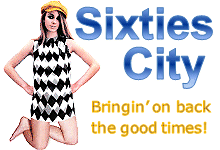

 |

|
|
Youth Culture
Like the hippies, they favoured longer hairstyles, although not to the same extent, and the men commonly sported thin beards along the jaw line and horn-rimmed glasses. This look was made more fashionable by the success of the Manfred Mann pop group in the early sixties who adopted this style with great success, adapting blues music to the Beat Boom. Another highly popular element around the music scene in the early Sixties were what are generically known as 'Irish Showbands', although this did not reflect in chart recording successes. Groups such as The Impact Showband and The Jivenaires often appeared as supporting acts to major chart-topping artists and groups at concerts in both the UK and the USA.
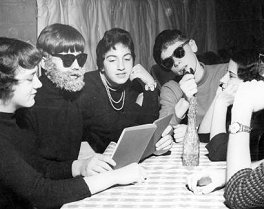 Beats |
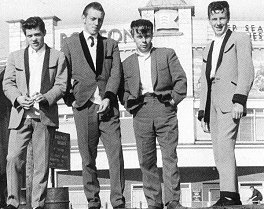 Teddy Boys |
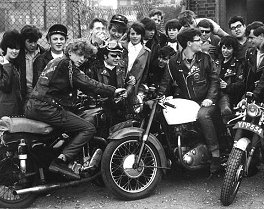 Rockers |
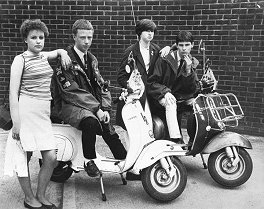 Mods |
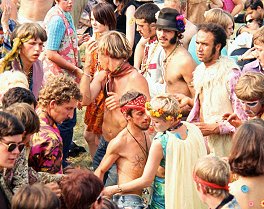 Hippies |
 Skinheads |
| The arrival of
the Mersey sound in 1962-3, notably The Beatles, and other influential groups
such as The Rolling Stones, The Animals and later, of course, The Who, led
to a rapid rise and growth in the cultural group - the mods - (short for
modernists) who seemed to come into being almost overnight but who had been
around among the fringe groups following modern jazz. A curiously British
phenomenon, their culture revolved mainly around dancing, music and creation
of a fashion statement, taking little notice, publicly, of girls. In order to get the energy for their 24 hour dance-til-you-drop lifestyle, mods popularised the perceived common use of drugs. There was always something happening somewhere and the Mod drug of choice, amphetamine, kept them going for days. Although available, marijuana did not fit in with the Mod culture as it had the effect of 'slowing down' not 'speeding up'. It is the modern perception that the Sixties youth society was rife with substances of various sorts, and there is no doubt that they were becoming increasingly available, particularly towards the close of the decade, but the fact is that they were generally pretty hard to get hold of and the actual overall usage was comparatively very low compared to today. With 'their own' music, fashions, dances and chosen method of transportation, the Italian 'scooter', friction inevitably began to arise between the Mods and the die-hard rock'n'roll, motorcycle culture of the Rockers as they were progressively ousted from their traditional haunts. To Rockers, Mods were effeminate, weedy, 'posh' snobs. The Mods viewed Rockers as being anachronistic, loutish and dirty. The Rocker 'stereotype' seemed to be viewed as 'Brylcreem', motor bikes, black leather and alcohol. Generally speaking, the Mod movement was based in the major cities, particularly rooted in London, whereas Rockers tended to be more rural. Mods had comparatively well-paid office jobs while Rockers were working class and the antagonism even stretched to musical tastes where there was virtually no common element. Fights fairly frequently occurred wherever 'territories' overlapped or simply when they came across each other. Some Mods took to sewing fish hooks into the backs of their lapels to damage the hands of their opponents. Weapons were also fairly common - flick knives being particularly common, along with coshes and knuckle-dusters. This rivalry came to a head in a series of pitched battles between the groups, usually at coastal resorts on Bank Holidays, when large numbers of the rival groups descended on the seaside towns in organised outings, or 'runs'. |
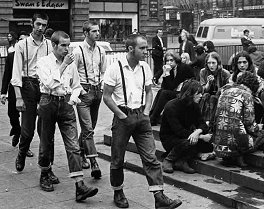 Skinheads and Hippies |
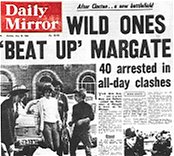 |
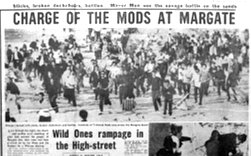 |
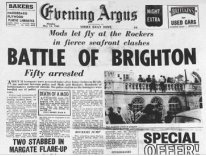 |
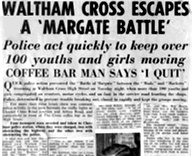 |
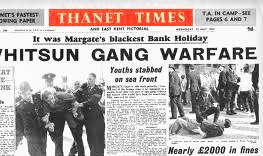 |
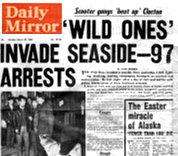 |
The first major confrontation
came at Margate on Whitsun weekend, 18th May 1964 resulting in a rampage of
violence and destruction around the town. It began at 7am on Sunday and by noon
there had already been 11 arrests. The trouble moved from the centre of the
town to the beach where about 100 Mods attacked something in the region of 30
Rockers. At its height, over 400 youths were estimated to have been involved,
with 51 arrested and fined a total of £1900, 3 of them also receiving
prison sentences. Dr. George Simpson, Chairman of The Bench, described them
as 'long-haired, mentally unstable petty little sawdust Caesars who seem to
find courage like rats by hunting in packs'. National
Archive: Report from the National Association of Youth Clubs on youth behaviour
during the August Bank Holiday in Brighton, 1965.
Mods &
Rockers - England in the 1960s The
Battle of Brighton Beach May 1964
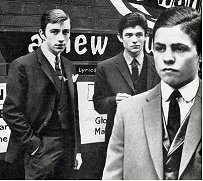 Marc Feld (Bolan) |
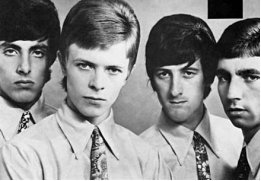 David Jones (Bowie) |
This
was followed by similar outbreaks at Brighton, Clacton, Broadstairs, Bournemouth,
Southend and Hastings but these almost ritual battles seem to have been
almost entirely confined to 1964 and 1965, appearing to die out almost overnight
as quickly as they had begun. This was no doubt helped along by an ever-increasing
police presence and a large number of arrests, but was more likely just
a result of natural transition of the mod culture which, by 1966 was in
decline, partially giving rise to the 'skinhead' movement.The
standard mod 'uniform' of the time consisted (for the average Mod) of the
American 'parka' style coat with fur-trimmed hood for protecting their expensive
shiny two-tone mohair suits while riding their highly decorated and customised
scooters. 'Aces' or the richer, highly fashionable Mods wore full length
leather coats. Other affectations were 'Fred Perry' or small collar shirts,
hipster trousers, bright patterned shirts, narrow ties and the famous 'winklepicker'
toed shoes or elastic-sided 'Chelsea' boots, although there were variations
on this theme as fashion changed so rapidly. American shirts (tab and button down) could be bought from an American gents outfitters on Shaftesbury Avenue for £59/11 (£2.98p) and Madras-striped cotton jackets were hunted for at various out of the way shops according to 'locals' knowledge. Rare 'white' Levi jackets could be acquired from a ships' chandlers in the East End along with a consignment of J.C. Penney's 'Harrington' jackets. Other favourites were red wool 3-button shirts, continental cycling jerseys and Italian 'driving-shoes', a type of loafer with a rubber heel back made by Ravel. Various styles came and went: round-toed, almond-toed, chisel-toed, winklepickers with the points chopped off. Hush Puppies or bowling shoes were big favourites as they were good for dancing and really 'In' were Clark's desert boots. Some Mods even took up the traditional 'city gent' look complete with brolly and bowler hat. The styling of jackets was of major importance, the deeper the side or back vents the better, being as much as 10" in extreme cases. The girls favoured hipsters, ski pants or long straight skirts, later taking up the mini skirt/dress fashion, often in PVC, with the stark, bold primary colours as used by Andre Courreges and, commonly, large black and white checks, stripes or op art designs. |
| Other
items included brightly coloured and patterned tights, soft bras and peaked
caps. Their hair was straight, chin-length and with a centre parting or
deep fringe. One of the more popular male styles involved having a short
half-parting high on the head from which the hair was back-combed with a
'bobble-brush' so that it gained height - as much as 2 or 3 inches - at
the back. The
main popular haunts were centred around the West End, particularly Soho,
in clubs like The Scene, The Scotch, The Ad-Lib, The Ram Jam, The Crazy
Elephant, La Discotheque and The Flamingo where the resident band were Georgie
Fame and The Blue Flames. Another top mod hangout was The Goldhawk Club
in Shepherd's Bush. Top mods, the ones responsible for initiating fads or
changes in style were known as 'faces' and often used mascara and eye make-up
to enhance their looks. There was quite a hierarchy in the mod movement
and various factions were known as 'stylists', 'individualists', 'numbers',
'tickets', 'mids', 'mockers', 'seven and sixes', 'states', 'moddy boys'
and 'scooter boys', amongst others. Constantly driven by changing music
and fashion tastes and styles, the mods appeared to diverge fairly rapidly
back into their various sub-cultures dependent on their individual or group
preferences. After 'mod' there followed a comparatively brief period of 'Regency', which was a 'Beau Brummel' look using buttons, bows, velvet and frills, epitomised by the dress of some of the major pop groups such as The Kinks and The Walker Brothers during 1966-67, and also the photographer Patrick Litchfield. Although these movements and fashions survived to some extent late into the decade they were eventually swamped by the huge influence of the hippie psychedelic 'flower power' culture of the mid to late Sixties by which time a new generation of teenagers were making their own individualism and preferences apparent. The subculture of 'skins' or 'skinheads emerged among London's working-class youth in the late 1960s, motivated by social alienation and a solidarity with the working class. They were recognisable by their shaved heads and working-class clothing, usually including short jeans with turnups and trouser braces, and boots or heavy working shoes. They rejected conservatism and austerity, adopting various elements of the mod, the Jamaican British and the Jamaican immigrant ‘rude boy’ subcultures. Their biggest musical influences were ska, rocksteady, reggae and sometimes African American soul and rhythm and blues. As this culture grew into the 1970s, skinheads got an increasingly bad reputation when right-wing racists started to copy their appearance. The right-wingers acquired a reputation for bigotry and were responsible for a wave of racist attacks, even though the Skins inclined towards the style of black youth in terms of music and some clothing. They were also responsible for a growing number of violent incidents during and after football games. The Skins' clothing style changed during the Seventies and adopted a ‘smoothie’ style with long hair, flared trousers and sleeveless tank-top jumpers, |
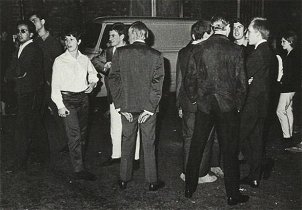 Skinhead girls |
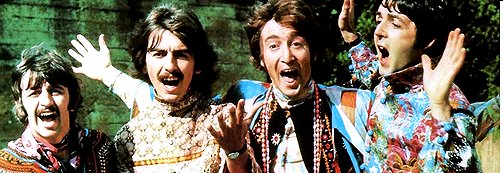 |
Hippies, the 'flower
power', make love not war, pro-drug, anti-establishment, protest music-loving
dropouts of the mid and late Sixties, wore whatever they wanted, doing 'their
own thing'. This generally derived from their LSD tripping, psychedelic
fantasy drug culture which reached its peak in 1967, flooding the 'alternative'
fashion world with kaftans, afghan-style coats, beads, body painting and
flowers in the hair. Brought to the fore by their protests about American involvement in Vietnam, the main centre of hippie activity was in San Francisco where thousands of them, many of them draft-dodgers, lived in communes which were the catalyst for the legendary huge outdoor rock Peace festivals of the Sixties using the music medium for their anti-war and personal freedom messages. Other major hippie centres were located in New York's East Village, Boston and Los Angeles in the States, but virtually every European country had its own centres and communes. The hippie movement really marked the end of cultural change in the Sixties. The early Seventies saw many of its own rises and falls, but there was a feeling of artificiality about it as if trying to regain the freshness and originality of the Sixties, which were purely spontaneous and not the false, commercially manufactured circus it has since turned into. Also see Sixties City: Soho-The Swinging Sixties |
Sex and Marriage
The
Hippies' "Make Love Not War" ethic was undoubtedly helped dramatically
by the contraceptive pill, which was introduced in the UK in January 1961, and
'Family Planning' became part of the services provided by the NHS in December
of that year. By 1964, the first Family Planning Clinic for unmarried women
had been opened. In the mid-1960s, only five per cent of single women lived
with a man before getting married. The Abortion Act, championed by David Steel,
went through Parliament in 1967, leading to a significant number of visitors
from other countries arriving on our shores to take advantage. Abortions rose
to 130,000 a year (10% of them within marriage).
Pope Paul VI (Humanae
Vitae July 25th 1968) on contraception:
"In conformity with these landmarks in the human and Christian vision of
marriage, we must once again declare that the direct interruption of the generative
process already begun, and, above all, directly willed and procured abortion,
even if for therapeutic reasons, are to be absolutely excluded as licit means
of regulating birth."
The British Nationality Act 1965 made provision for women married to British
subjects without citizenship to acquire British subject status by registration.
The Divorce Reform Act of 1969 reduced the concept of a 'guilty party', replacing
it with 'irretrievable breakdown' which allowed suing for divorce after 2 years
separation by consenting couples and 5 years without consent. The 1970 Matrimonial
Property Act which gave women more property rights was needed to apply the law
more properly and fairly. Attempts to decriminalise homosexuality had failed
in both 1962 and 1966, but was eventually ratified by an Act in 1967 that allowed
homosexual acts between consenting adults, over the age of 21, in privacy.
Op Art
Other facets of the 'psychedelia'
of the Sixties included Pop-art and Op-art. Although sounding similar, and often
believed to be the same thing, they were quite distinctly different art forms.
'Op' art, or optical art, relies on visual illusion and is also known as retinal
art. Op-artists use geometric designs to create the impression of movement or
vibration, sometimes in colour but generally mostly seen in high-contrast black
and white. Emerging in the 1920s as an art form, the Sixties Op Art movement
partly originated in the designs of Victor Vasarely who created images with
bizarre perspectives, and also from the Abstract Expressionist movement that
denied the importance of any subject matter. The name itself was coined in a
1964 article in 'Time' magazine.
As a result of a 1965 Op Art creation entitled "The Responsive Eye" attracting
huge public interest the style began appearing in many different media including
fashion, interior design, advertising and album art but, despite its commercial
popularity, it never achieved the recognition as an art movement that Pop Art
did. The primary objective of Op-Art is to fool the visual sense, creating an
illusion of movement and depth from a two-dimensional work. With its base in
geometric patterns this form of art is almost completely non-representational,
created for the purpose of visual illusion and not to affect moods or emotions.
Colour, or more usually contrast, and perspective are carefully selected to
achieve the end result and the negative spaces in the composition are always
of equal importance.
Hungarian Victor Vasarely produced early examples in the 1920s and artists such
as Bridget Riley, Frank Stella and Richard Anuszkiewicz were attaracted to this
'new' movement that explored a purely optical art form stripped of perceptive
associations and the optical trickery of line and contrasting areas of colour
were the inspiration to clothes designers like Courreges, Ungaro and Julian
Tomchin. Bridget Riley's early works were mainly in black and white, painted
on a large scale, in an attempt to produce visual disturbances in the viewer
by the use of moire patterns that confused the eye.
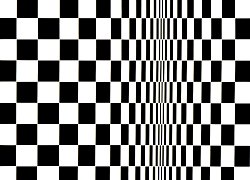 |
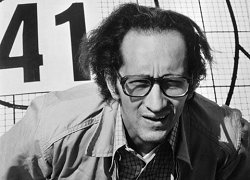 |
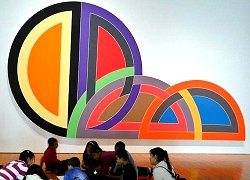 |
 |
At the forefront of the Sixties
Op and Pop Art scene were two galleries run by dealers Kasmin and Robert Fraser.
Kasmin, a Jewish intellectual and sometime poet, was probably the most successful
art dealer in London's Bond Street and his galleries frequently included works
by David Hockney and members of the American avant-garde. 'Groovy Bob' Robert
Fraser was an old Etonian and a 'dedicated follower of fashion' who led a wildly
promiscuous homosexual lifestyle that epitomised the 'Swinging London' of the
Sixties. His gallery exhibited the Op-art of Bridget Riley and he is recognised
as the dealer responsible for introducing Roy Lichtenstein, Jasper Johns, Andy
Warhol and Jim Dine to the London art world. Although financially somewhat unreliable
he was a major figure in the fashionable London scene, rubbing shoulders with
music, showbiz and film stars. Fraser started using increasing quantities of
drugs and, in 1967, he was arrested along with Mick Jagger and Keith Richards
in the famous Redlands drugs bust and was sent to prison for six months, an
event immortalised in Richard Hamilton's painting 'Swingeing London' that depicts
a handcuffed Fraser and Jagger on their way to prison.
The Indica Bookshop, which rapidly became a focal point for London's 'counterculture',
was established by Barry Miles in 1966. Underneath the shop was the Indica Gallery,
a small space run by John Dunbar ( then married to Marianne Faithfull) and supported
by Paul McCartney. Dunbar, not having a contemporary art background, wasn't
particularly interested in the mainstream 'establishment' art world and concentrated
on exhibiting many of the Sixties 'underground' artists - including now well-known
names such as Yoko Ono and the Boyle Family. It was here that John Lennon first
met Yoko Ono. Other 'underground' artists included Barry Flanagan, Gustav Metzger,
John Latham, Otto Muehl, David Medalla, Liliane Lijn, Bruce Lacey and Stuart
Brisley. Brisley, like Yoko Ono, was involved in the early days of 'performance
art' and in the late Sixties vomited on the audience during his shows at the
Royal Court and the ICA.
Pop Art
Pop-art was a movement that emerged
in the late Fifties as a reaction to the seriousness given to abstract impressionism.
It attempted to fuse elements of, and remove boundaries between, popular and
high culture. The main exponents of Pop-art, spearheaded by artists such as
Peter Blake and Robert Rauschenberg, were
Roy Lichtenstein, Allen Jones, Tom Wesselman, John McHale and, of course, Andy
Warhol and David Hockney. Their style was simplistic, reducing a subject
to its lowest common denominator and then converting it with exaggerated colour
to express abstract formal relationships.
Possibly the best known examples of this were Warhol's silk-screen paintings
that made use of monotony and repetition such as the images of Marilyn Monroe
and Elvis, but many other of the more famous pictures involved everyday objects
such as soup tins, cans of baked beans, Coca Cola bottles and the dollar bill.
Both types of image appealed to the rebellious nature of Sixties youth, being
the antithesis of the older generation's concept of art and hardly a teenager's
bedroom wall didn't sport Pop or Op art posters in some form or other. Warhol
went almost completely bald before he was 20. He wore brown wigs at first, but
in line with his outrageous art he adopted much more flamboyant silver, blue
and his favourite white ones. He had a collection of more than 500, all of them
made by the same wig-maker in Manhattan.
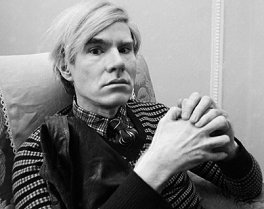 |
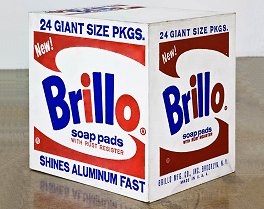 |
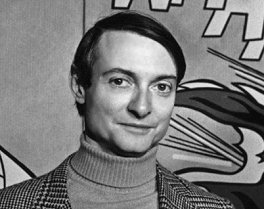 |
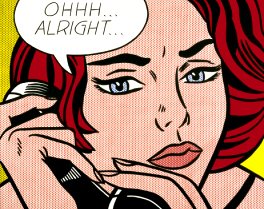 |
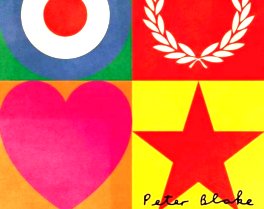 |
Andy Warhol also diversified into the film industry where he gave us a 3 hour silent film of a man sleeping, called 'Sleep' and an 8 hour view of the Empire State building called - you guessed it - 'Empire'. Apart from these, he produced 'Kiss', 'Blow-Job', 'Flesh', 'Harlot' and 'Trash' and also gave us Edie Sedgwick, Nico and Velvet Underground. The 'underground' press that thrived in Europe and America from around 1966 were also influencing or being influenced by this.
One of the most famous underground magazines was 'OZ', created by Richard Neville, which featured humorous or satirical articles by young authors such as Clive James and Germaine Greer. The various publications became a channel for youth to produce its own alternative to the more ordinary magazines on sale and led the way for a sub-culture of 'underground' groups, festivals and films.| British
sculpture in the Sixties progressed, in ten short years, from Henry Moore's
bronzes to Gilbert and George tea parties. Anthony Caro, a former assistant
to Henry Moore and an art teacher at St Martin's college, returned from
the USA in 1960 after meeting highly influential art critic Clement Greenberg.
He ceased making bronzes supported by plinths and started creating colourful abstract steel structures that sat directly on the floor. Together with Bill Tucker, Phillip King, Michael Bolus and Tim Scott he spearheaded a break with tradition into the world of abstract sculpture. Their work was supported by a teenage Alistair McAlpine who had inherited a fortune from the family building trade and ploughed it into collecting examples of this radical new art form. Within two years, a new generation of artists including Bruce McLean and Barry Flanaghan were looking even further than the abstract sculpture that was now established at St Martin's, with Richard Long and Hamish Fulton exploring whether going for a walk could be seen as 'art' and Gilbert and George (Gilbert Proesch and George Passmore), whose works included tea parties where they served cold baked beans in ice cream cones and performances in which they sang along to Flanagan and Allen's 'Underneath the Arches', starting their lifelong collaboration. |
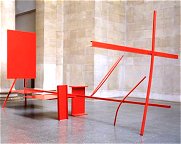 |
|
|
All
Original Material Copyright SixtiesCity
Other individual owner copyrights may apply to Photographic Images |